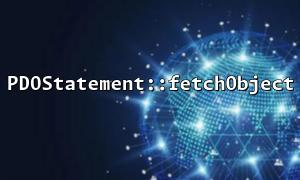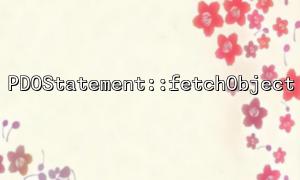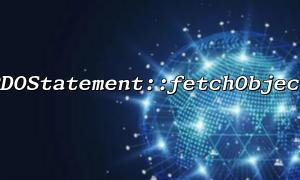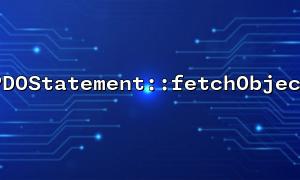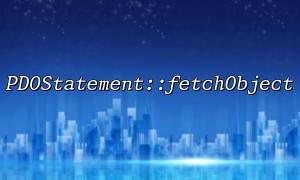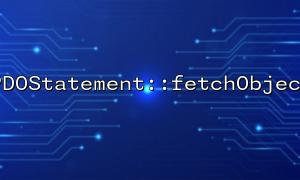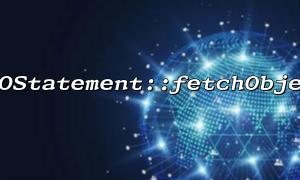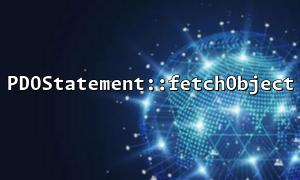In PHP, PDO (PHP Data Objects) provides a lightweight database access layer that allows us to operate databases more efficiently. Performance optimization is a very critical part of database queries, and using caching mechanisms is one of the common ways to improve performance. In this article, we will explore how to optimize the performance of database queries by combining PDOStatement::fetchObject function with data cache.
PDOStatement::fetchObject is a function in the PDO class that allows us to obtain database query results in the form of objects. This is more convenient than the traditional PDOStatement::fetch returning an associative array, especially when we want to map the query results to a class object. It converts each row result into a specified class object, rather than an array.
<?php
// Create a database connection
$dsn = 'mysql:host=localhost;dbname=testdb';
$username = 'root';
$password = '';
$options = array(
PDO::ATTR_ERRMODE => PDO::ERRMODE_EXCEPTION,
PDO::ATTR_DEFAULT_FETCH_MODE => PDO::FETCH_OBJ,
PDO::ATTR_EMULATE_PREPARES => false
);
try {
$pdo = new PDO($dsn, $username, $password, $options);
// Query statement
$stmt = $pdo->prepare("SELECT * FROM users WHERE id = :id");
$stmt->execute(['id' => 1]);
// Get the result object
$user = $stmt->fetchObject();
echo "user ID: " . $user->id . "<br>";
echo "user名: " . $user->username . "<br>";
} catch (PDOException $e) {
echo "Connection failed: " . $e->getMessage();
}
?>
In this example, we use the fetchObject method to get a row of data from the users table from the database and convert it into a PHP object.
Every time a query is made from a database, especially for large applications, it will have a certain impact on performance. Database queries not only consume I/O resources, but also consume a lot of server time. In order to improve query efficiency, the caching mechanism can greatly reduce the burden on the database, especially when we need to frequently access the same data, the cache can directly provide the data, thereby avoiding duplicate database queries.
Reduce database pressure : By cached duplicate query results, the frequency of querying the database is reduced and the load on the database is reduced.
Improve response speed : The cache can quickly return data, which significantly reduces page loading time.
Reduce resource consumption : avoid unnecessary database operations and save CPU, memory and other server resources.
In order to implement data caching during database query, we can combine common caching techniques such as Redis or Memcached to cache query results. Here is a simple example showing how to use PHP and Redis to cache query results.
Check the cache : Before conducting a database query, check whether the corresponding data exists in the cache.
Query database : If there is no data in the cache, perform a database query.
Cache data : Store the query results in the cache for next use.
<?php
// connect Redis
$redis = new Redis();
$redis->connect('127.0.0.1', 6379);
// Create a database connection
$dsn = 'mysql:host=localhost;dbname=testdb';
$username = 'root';
$password = '';
$options = array(
PDO::ATTR_ERRMODE => PDO::ERRMODE_EXCEPTION,
PDO::ATTR_DEFAULT_FETCH_MODE => PDO::FETCH_OBJ,
PDO::ATTR_EMULATE_PREPARES => false
);
try {
$pdo = new PDO($dsn, $username, $password, $options);
// userID
$userId = 1;
// Check whether data exists in the cache
$cacheKey = "user_$userId";
$cachedData = $redis->get($cacheKey);
if ($cachedData) {
// If the cache exists,Return cached data directly
$user = json_decode($cachedData);
} else {
// If the cache does not exist,Query from the database
$stmt = $pdo->prepare("SELECT * FROM users WHERE id = :id");
$stmt->execute(['id' => $userId]);
// Get query results
$user = $stmt->fetchObject();
// Cache data to Redis
$redis->set($cacheKey, json_encode($user), 3600); // Set up cache1Hour
}
echo "user ID: " . $user->id . "<br>";
echo "user名: " . $user->username . "<br>";
} catch (PDOException $e) {
echo "Connection failed: " . $e->getMessage();
}
?>
In this example, we first check whether there is user data in the Redis cache. If the cache exists, the cached data is directly returned; if the cache does not exist, the data is queried from the database and stored in the cache for next use. In this way, we can significantly improve the performance of database queries.
By combining PDOStatement::fetchObject and caching mechanism, we can effectively improve the performance of database queries. In high concurrency application scenarios, a reasonable caching strategy can significantly reduce database pressure and shorten user waiting time, thereby improving overall system performance and user experience. The above is the basic idea of implementing data caching through fetchObject , I hope it will be helpful to you.
Related Tags:
PDOStatement
